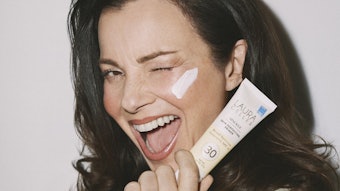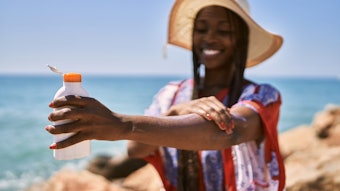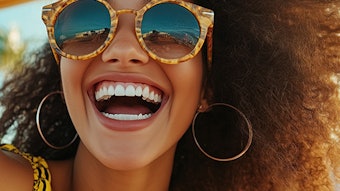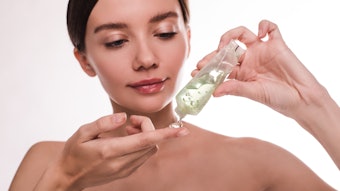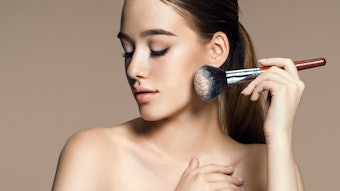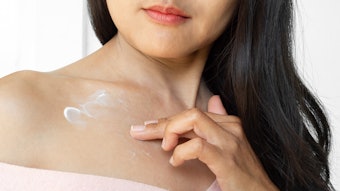
This 'Read the Label' reviews Nivea’s Sun Protect & Dry Touch Sunscreen Spray SPF 50. The brand claims this product provides reliable and immediate UVA/UVB protection.
Related: Beiersdorf Launches Chaul Skin Care
Based in Germany, Beiersdorf is the umbrella company for leading global brands such as Nivea, Eucerin and La Prairie. Focusing on Nivea as Beiersdorf’s largest brand, the company began in 1911 when launching its iconic "creme" product in the "famous" blue pot packaging. This was reportedly the first stable emulsion cream for cosmetic applications in the world and its success has still stands even to today, more than 100 years later.
Nivea’s focus is skin care but it has since expanded into deodorants, sun care, micellar waters, wipes, color cosmetics and other areas, too. As stated, this "Read the Label" focuses on sunscreens with a specific look at Nivea’s Sun Protect & Dry Touch Sunscreen Spray SPF 50.
The brand claims this product provides reliable and immediate UVA/UVB protection. It is fast-absorbing, water-resistant and leaves the skin feeling refreshed and silky. The formula is transparent, light and non-greasy, and is absorbed into the skin with no white marks left behind. The product is also sprayable upside-down, which makes it easy to apply all over the body, and is packaged using recycled plastic.
Before using the sunscreen, the product must be shaken well then sprayed all over the body. It should be massaged into the skin to ensure even coverage and a quick drying time. Regular touch-ups should be applied throughout the day. Of the product's following ingredient disclosure, those listed in bold are ones I believe are strongly contributing to the product's performance and claims:
Ingredients: Alcohol Denat., C12-15 Alkyl Benzoate, Homosalate, Octocrylene, Glycerin, Butyl Methoxydibenzoylmethane, Ethylhexyl Salicylate, Isopropyl Palmitate, Propylheptyl Caprylate, Tocopherol, Acrylates/Octylacrylamide Copolymer, Aqua, Linalool, Limonene, Benzyl Alcohol, Benzyl Salicylate, Alpha-Isomethyl Ionone, Citronellol, Coumarin, Geraniol, Methyl Benzoate, Hexyl Cinnamal, Parfum.
Previously: Beiersdorf's Allergen-free Fragrance Emanates Dermatologic Potential
Editor's note: While the "Read the Label" series provides an overview of the ingredients cosmetic manufacturers use and their related claims, without use levels or access to clinical studies, the author is drawing conclusions based on speculation—albeit from training, formulating experience and, in some instances, evidence in the literature. The following is offered for your consideration and further verification.
C12-15 Alkyl Benzoate
This is an excellent solubilizer for lipophilic materials, and particularly good for sunscreens and volatile silicones. It will also contribute to the product's spreadability and help to remove any tack/stickiness.
Homosalate
This ingredient is a globally accepted UVB organic filter that has good solubility in high alcohol systems and helps to solubilize other hard-to-dissolve sunscreen filters. It is also soluble in a wide variety of esters but is insoluble in high water-containing formulas. It is usually a clear, slightly yellow liquid and usage levels can be up to 10-15%, depending on local laws.
Octocrylene
This UVB absorber allows users to create high SPF formulas. It has slight water repellency and can improve water resistance in sunscreens. It helps to improve the solubility of butyl methoxydibenzoylmethane (avobenzone) and is a yellow, oil-soluble, viscous liquid. Typical use levels are between 7-10%.
Glycerin
As glycerin is positioned in this product's ingredient list between octocrylene (max use 10% EU) and butyl methoxydibenzoylmethane (max use 5% EU), formulators can work out that the concentration of glycerin will be between around 5-10% in this formula or maybe slightly less, which is typical of this ingredient. Anything over 10% will make the formula tacky and will slow down the drying time but under this concentration, the glycerin will provide long-lasting skin hydration.
It is a humectant that attracts moisture from its surroundings to draw it into the skin. Formulators can quite easily reduce the tackiness of glycerin by adding materials that give a powdery after-feel such as silica, talc, starch, silicones, etc., but in this formula, the C12-15 alkyl benzoate will significantly remove any tack from the oily SPF filters used.
Featured: Eucerin Launches First Global Umbrella Campaign
Butyl Methoxydibenzoylmethane
Known as avobenzone, this ingredient is an organic sunscreen filter that absorbs UVA rays, particularly in the 340-400 nm region. It is oil-soluble and usually comes in crystal form.
Due to its sun protection factor, it helps to protect skin against photodamage and premature skin aging. The max use level is between 3-5%, depending on local laws.
Ethylhexyl Salicylate
This ingredient is another organic sun filter that absorbs UVB radiation. It is mostly used as a secondary sun filter ingredient and it can boost a product's SPF to high levels due to it being a great solvent for other SPF filters. This material can be used up to 5% globally and it comes in a yellow liquid form.
Isopropyl Palmitate (IPM)
An ester of isopropanol and palmitic acid, IPM is a commonly used cost-effective emollient. It provides high moisturization and conditioning properties to the skin whilst being soluble in most oils.
Propylheptyl Caprylate
This is another ester emollient that helps with the sunscreen’s superior spreading properties, essential in ensuring a homogenous layer of SPF is applied over the skin to avoid unprotected areas.
Acrylates/Octylacrylamide Copolymer
Finally, this key film-former is used to provide waterproofing effects, as well as keep the product on the skin over long periods.
Consumers can buy this sunscreen online, in supermarkets or in drug stores for £10.50 for 200 mL ($13.70 for 6.7 fl. oz.).
Source: Nivea
Disclaimer: This article was produced in the UK and therefore the INCI listing and INCI names comply with European labeling requirements.

